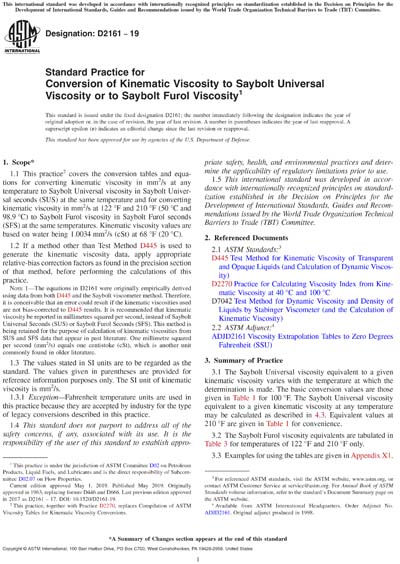Historical
ASTM D2161-19
Standard Practice for Conversion of Kinematic Viscosity to Saybolt Universal Viscosity or to Saybolt Furol Viscosity
1.1 This practice2 covers the conversion tables and equations for converting kinematic viscosity in mm2/s at any temperature to Saybolt Universal viscosity in Saybolt Universal seconds (SUS) at the same temperature and for converting kinematic viscosity in mm2/s at 122 °F and 210 °F (50 °C and 98.9 °C) to Saybolt Furol viscosity in Saybolt Furol seconds (SFS) at the same temperatures. Kinematic viscosity values are based on water being 1.0034 mm2/s (cSt) at 68 °F (20 °C).
1.2 If a method other than Test Method D445 is used to generate the kinematic viscosity data, apply appropriate relative-bias correction factors as found in the precision section of that method, before performing the calculations of this practice.
Note 1: The equations in D2161 were originally empirically derived using data from both D445 and the Saybolt viscometer method. Therefore, it is conceivable that an error could result if the kinematic viscosities used are not bias-corrected to D445 results. It is recommended that kinematic viscosity be reported in millimetres squared per second, instead of Saybolt Universal Seconds (SUS) or Saybolt Furol Seconds (SFS). This method is being retained for the purpose of calculation of kinematic viscosities from SUS and SFS data that appear in past literature. One millimetre squared per second (mm2/s) equals one centistoke (cSt), which is another unit commonly found in older literature.
1.3 The values stated in SI units are to be regarded as the standard. The values given in parentheses are provided for reference information purposes only. The SI unit of kinematic viscosity is mm2/s.
1.3.1 Exception—Fahrenheit temperature units are used in this practice because they are accepted by industry for the type of legacy conversions described in this practice.
1.4 This standard does not purport to address all of the safety concerns, if any, associated with its use. It is the responsibility of the user of this standard to establish appropriate safety, health, and environmental practices and determine the applicability of regulatory limitations prior to use.
1.5 This international standard was developed in accordance with internationally recognized principles on standardization established in the Decision on Principles for the Development of International Standards, Guides and Recommendations issued by the World Trade Organization Technical Barriers to Trade (TBT) Committee.
Content Provider
ASTM International [astm]






